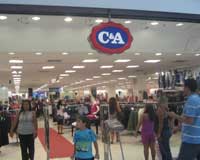"C&A, the global Dutch chain of retail clothing stores, recently launched a line of T-shirts certified by the Cradle to Cradle standard. This essentially implies they are designed and manufactured in an eco-friendly way and whose materials can be recirculated safely back into industrial materials or composted into the soil. For the company, it was no cake walk. It required a board-level commitment, close partnerships with contract manufacturers, an arduous search for replacements for problematic materials and some new messaging to customers."

C&A, the global Dutch chain of retail clothing stores, recently launched a line of T-shirts certified by the Cradle to Cradle standard. This essentially implies they are designed and manufactured in an eco-friendly way and whose materials can be recirculated safely back into industrial materials or composted into the soil. For the company, it was no cake walk. It required a board-level commitment, close partnerships with contract manufacturers, an arduous search for replacements for problematic materials and some new messaging to customers.
Transitionary phase

C&A backed up the aspiration with a range of sustainability initiatives, particularly related to its materials selection and supply chain. The company is the world’s largest buyer in volume terms of organic cotton, as per 2016 Textile Exchange's Organic Cotton Market Report. The circular economy initiative began at C&A from 2015 when the Brenninkmeijer family invited designer William McDonough to speak at its annual seminar. McDonough and the family discussed the idea of creating a ‘factory of the future’. Jeffrey Hogue, Chief Sustainability Officer, C&A, explained it was all about a world-class factory that would have all of the circular economy elements in it, where the water’s cleaner going out than coming in, 100 per cent renewable energy, great building, great livelihoods for the workers, high social and environmental standards and also a living wage. A three-person task force, from both the company and its foundation, set out to study how such a factory could be built, most likely in Bangladesh, China or India. But along the way, the group realised the factory of the future is a metaphor for something bigger, something that could be transformational in the apparel industry: to shift from a linear model to a circular model.
This realisation resulted in a partnership between C&A and the C&A Foundation to create ‘Fashion for Good’ in a renovated building in Amsterdam. The facility, which opened in March, houses programs for both early- and late-stage innovators, along with interactive exhibits and other initiatives that center around five aspects of ‘good’: good materials, good economy, good energy, good water and good lives.
Getting companies onboard
While taking the step was just the beginning. The greater task was in finalising suppliers who could live upto the desired expectation. C&A turned to Indore-based Pratibha Syntex, for help. Pratibha is a longtime C&A supplier, and a pioneer in many sustainability initiatives. For instance, almost 30 per cent of Pratibha’s factory power comes from the 5-megawatt solar panels it installed, and the company recycles more than 90 per cent of its wastewater.
It took seven or eight months to find dyes that would meet the C2C standard for the wide range of colours demanded by C&A. Organic sewing thread had to be imported from Switzerland, at 10 times the price of conventional thread. It took nearly a year to get the printing right for the t-shirt’s cotton care labels. Donald Brenninkmeijer estimated that the cost of making a C2C T-shirt is 5 to 10 per cent higher than a conventional one.
It was important that the product be launched much like any other, and not treated as a sideshow. Said van der Zee, chief merchandiser, C&A, if you truly believe that this is a game-changer in the industry and you really want to set this up for success — going not just for one-off but for continuous improvement and continuous increase — then you have to start with some scale because otherwise it never will be scalable.
Poised for success
Going by the initial response, C&A has charted a roadmap for more, and more complicated, C2C items to roll out in 2018 and 2019. First and foremost is to develop patterned t-shirts, adding stripes, embroidery and other design elements. A search is on for a C2C substitute for elastane — an elastic polyurethane material commonly found in hosiery, underwear and other clothing, which would allow for more stylish, form-fitting tops. Finding an elastane substitute also would open up new categories such as underwear. Nightwear is also on the agenda. Donald Brenninkmeijer hopes that half of C&A product introductions will be C2C-certified within a decade. This journey can be travelled alone. The company aims to encourage others to participate in this game changing movement. This is how the industry together can learn and develop a sustainable ecosystem.












